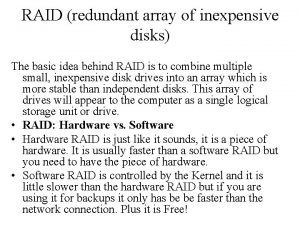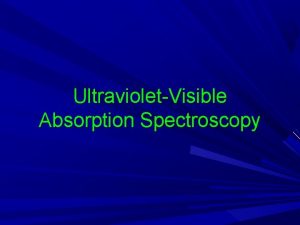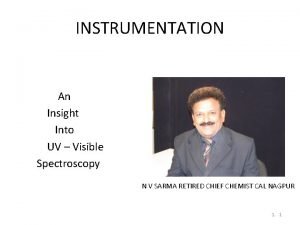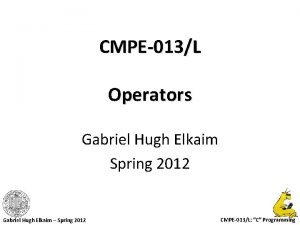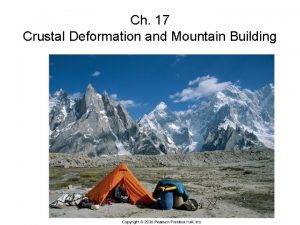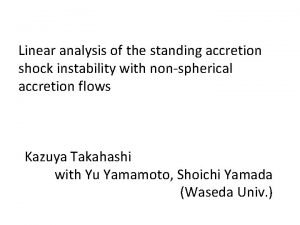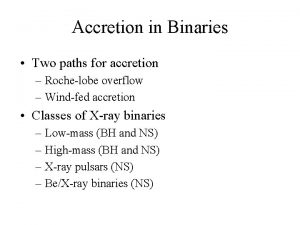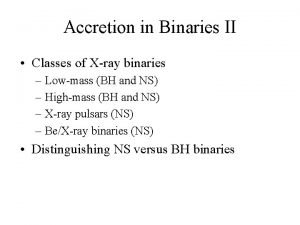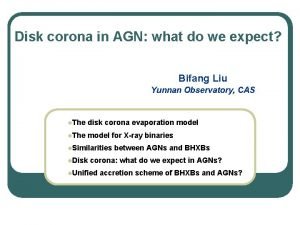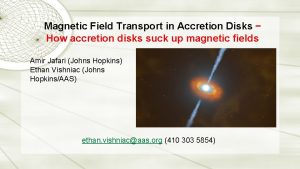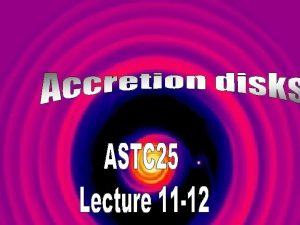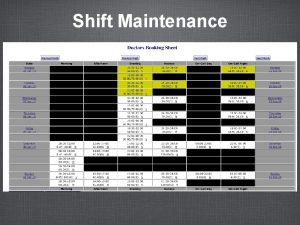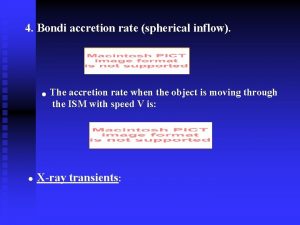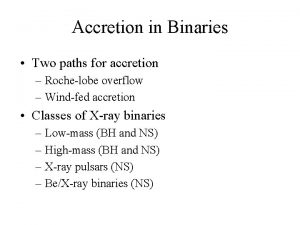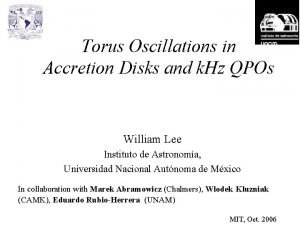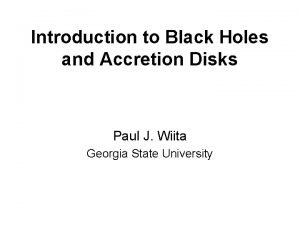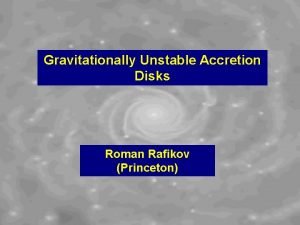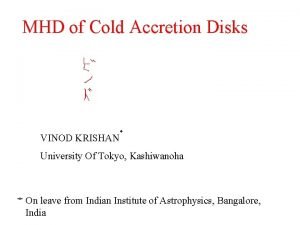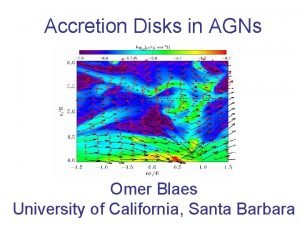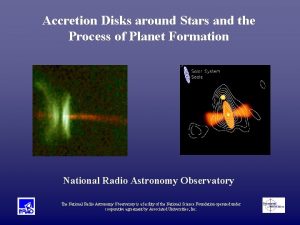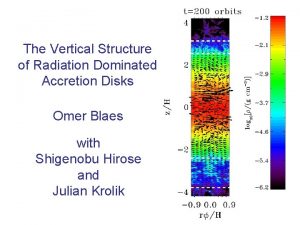LINE SHIFT IN ACCRETION DISKS THE CASE OF




















- Slides: 20

LINE SHIFT IN ACCRETION DISKS - THE CASE OF Fe Kα P. Jovanović1, V. Borka Jovanović2, D. 2 Borka 1 Astronomical 2 Lab. and L. Č. 1 Popović Observatory, Belgrade, Serbia 040, Vinča Institute of Nuclear Sciences, Belgrade, Serbia

Outline The broad Fe Kα spectral line Influence of the following shift types on the line profile: classical Doppler shift special relativistic transverse Doppler shift and Doppler beaming general relativistic gravitational redshift Our results - simulations of the Fe Kα line emitted from: a relativistic accretion disk around a single supermassive black hole (SMBH) two accretion disks around both components of a SMBH binary Conclusions

The broad Fe Kα spectral line from AGN broad emission spectral line at 6. 4 ke. V asymetric profile with narrow bright blue peak and wide faint red peak Line width corresponds to high velocity: v ~ 100. 000 km/s (MCG-6 -30 -15) v ~ 48. 000 km/s (MCG-5 -23 -16) v ~ 20000 – 30000 km/s (many other) The Fe Kα line profile from Seyfert I galaxy MCG-6 -30 -15 observed by the ASCA (Tanaka, Y. et al, 1995, Nature, 375, 659) and the modeled profile expected from an accretion disk around a Schwarzschild BH.

Production of Fe Kα: thin disk + hot corona Comptonized photons irradiate accretion disk with power law spectrum Compton reflection hump at 30 ke. V Flourescent emission line at 6. 4 ke. V Fabian, A. C. 2006, AN, 327, 943 Wilms et al. 2004, Mem. SAI, 75, 519

Classical and relativistic shifts in the case of the Fe Kα line Classical Doppler shift: symmetric, double-peaked profile Special relativistic transverse Doppler shift and relativistic beaming: enhance blue peak relative to red peak General relativistic gravitational redshift: smearing blue emission into red: Fabian, A. C. 2006, AN, 327, 943

Observed variability of the Fe Kα line from MCG-6 -30 -15 due to gravitational redshift Peculiar Time-avg 1994 1997 Both peculiar line shapes can be explained by large gravitational redshift in small radii on the accretion disk Reynolds, C. S. , Nowak, M. A. 2003, Physics Reports, 377, 389

Our results: model of a relativistic accretion disk based on ray-tracing in Kerr metric Armitage & Reynolds, 2003, MNRAS, 341, 1041 • Surface emissivity of the disk: • Total observed flux: • Energy shift:

Simulations of a highly inclined accretion disk around a Kerr SMBH with different spins (left), and the corresponding simulated Fe Kα line profiles (right) Jovanović & Popović, 2008, Fortschr. Phys. 56, 456 Simulations of a disk with different inclinations around a Schwarzschild SMBH (left), and the corresponding simulated Fe Kα line profiles (right)

Profiles of the Fe Kα line emitted from narrow rings in accretion disk

Modeled Fe Kα spectral line profiles for several values of SMBH spin a, and for inclination angles i = 20º (left) and i = 40º (right) Chandra observations of the Fe Kα line emitted from the nucleus of Cygnus A (3 C 405) (black crosses with error bars), and the corresponding simulated profiles for 4 different values of black hole spin (solid color lines). Jovanović, Borka, 2011, Baltic Astronomy, 20, 468

Variability of the Fe Kα line due to a bright spot in accretion disk Perturbed disk emissivity: Simulated emissivity perturbations along the receding (left) and approaching (right) side of a disk in Schwarzschild metric, and the corresponding variability of the Fe Kα line profile Jovanović, P. , Popović, L. Č. , Stalevski, M. , Shapovalova, A. I. 2010. Ap. J, 718, 168

Variability of the Hβ line in the case of quasar 3 C 390. 3 Jovanović, P. , Popović, L. Č. , Stalevski, M. , Shapovalova, A. I. 2010. Ap. J, 718, 168

Fragments of spiral arms in accretion disk of 3 C 390. 3 Jovanović, P. , Popović, L. Č. , Stalevski, M. , Shapovalova, A. I. 2010. Ap. J, 718, 168

Doppler shifts due to orbital motion of SMBH binaries Composite line profiles: Keplerian radial velocity curves: Semiamplitudes:

Doppler shifts due to the radial velocities of the primary and secondary SMBHs and variability of the composite Fe Kα line Example I: q = 0. 5, a = 0. 01 pc, i = 30 o, e = 0, ω = 90 o Example II: q = 1. 0, a = 0. 01 pc, i = 60 o, e = 0. 75, ω = 90 o

Shape of the Fe Kα line in the case when secondary SMBH is embedded in the accretion disk around the primary Two examples of accretion disk with an empty gap caused by the secondary SMBH, and the corresponding Fe Kα line profiles

Left: decomposition of the observed Hα line of NGC 4151 into three Gaussian components Top: Keplerian radial velocity curves of the sub-parsec SMBH binary in the core of Seyfert galaxy NGC 4151

Conclusions We developed and performed simulations of the X-ray radiation from relativistic accretion disks around single and binary SMBHs, based on ray-tracing method in Kerr metric The shape of the emitted broad Fe Kα line is strongly affected by three types of shifts: classical Doppler shift - causing double-peaked profile special relativistic transverse Doppler shift and relativistic beaming - enhancing blue peak relative to red one general relativistic gravitational redshift - smearing blue emission into red one The obtained simulated Fe Kα line profiles enabled us to study space-time geometry, accretion physics and strong gravity effects in vicinity of SMBHs Shifted, complex Fe Kα line profiles with ripple variability could represent observational signatures of the binary SMBHs

Thank you for attention!

 A case for redundant arrays of inexpensive disks
A case for redundant arrays of inexpensive disks Woodward fieser rule
Woodward fieser rule Aniline uv spectrum
Aniline uv spectrum Cap 221
Cap 221 Bathochromic shift and hypsochromic shift
Bathochromic shift and hypsochromic shift Difference between arithmetic shift and logical shift
Difference between arithmetic shift and logical shift Verilog
Verilog Difference between arithmetic shift and logical shift
Difference between arithmetic shift and logical shift Difference between arithmetic shift and logical shift
Difference between arithmetic shift and logical shift Movement of mandible muscles
Movement of mandible muscles Model of latin american city
Model of latin american city Accretion expense
Accretion expense Plunging anticline
Plunging anticline Zone of in situ accretion
Zone of in situ accretion Standing accretion shock instability
Standing accretion shock instability Accretion
Accretion Accretion
Accretion Accretion disk corona
Accretion disk corona Best worst and average case
Best worst and average case Tower of hanoi 4 disks
Tower of hanoi 4 disks A mechanism that spins reads and writes disks
A mechanism that spins reads and writes disks
